D-Link DWR-116 User Manual
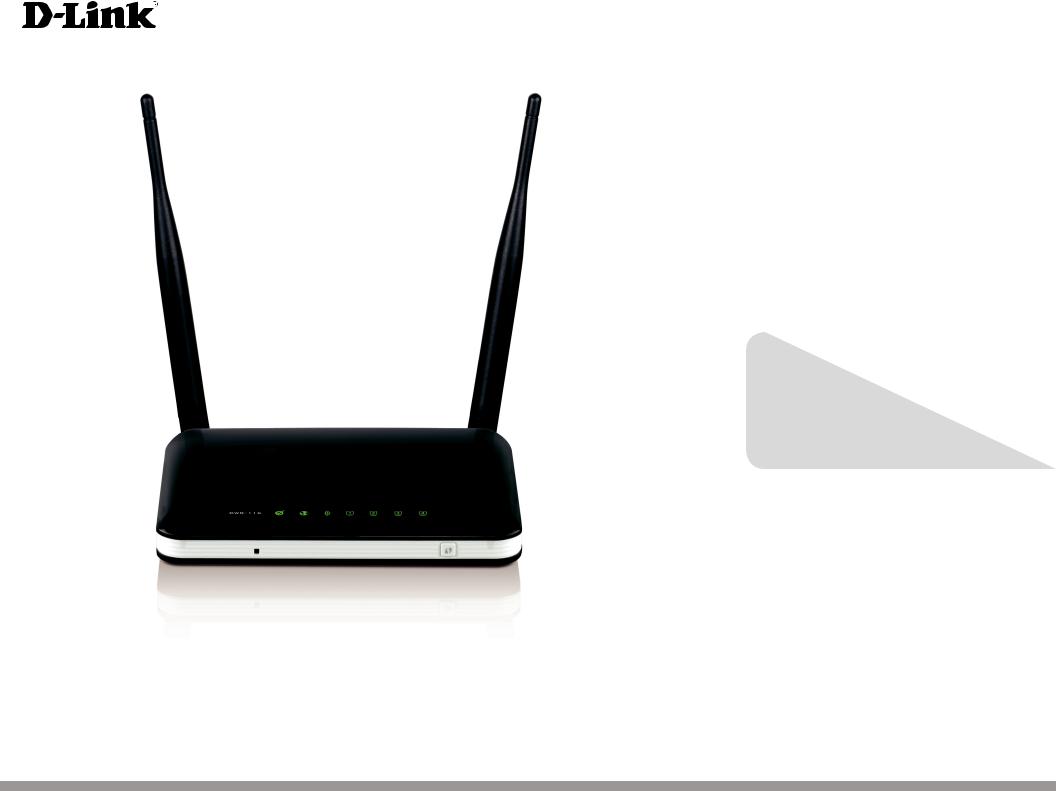
Version 1.0 | 05/24/2013
User Manual
Wireless N300 Multi-WAN Router
DWR-116

Preface
D-Link reserves the right to revise this publication and to make changes in the content hereof without obligation to notify any person or organization of such revisions or changes.
Manual Revisions
Revision |
Date |
Description |
1.0 |
May 24, 2013 |
• Initial release for Revision A1 |
|
|
|
Trademarks
D-Link and the D-Link logo are trademarks or registered trademarks of D-Link Corporation or its subsidiaries in the United States or other countries. All other company or product names mentioned herein are trademarks or registered trademarks of their respective companies.
Copyright © 2013 by D-Link Corporation.
All rights reserved. This publication may not be reproduced, in whole or in part, without prior expressed written permission from D-Link Corporation.
D-Link DWR-116 User Manual |
i |

Table of Contents
Table of Contents
Preface.................................................................................. |
i |
Manual Revisions........................................................................... |
i |
Trademarks....................................................................................... |
i |
Product Overview............................................................... |
1 |
Package Contents......................................................................... |
1 |
System Requirements.................................................................. |
1 |
Introduction.................................................................................... |
2 |
Hardware Overview...................................................................... |
3 |
Back Panel................................................................................ |
3 |
Front Panel and LEDs........................................................... |
4 |
Top.............................................................................................. |
5 |
Installation.......................................................................... |
6 |
Connect to Your Network........................................................... |
6 |
Wireless Installation Considerations...................................... |
7 |
Configuration...................................................................... |
8 |
Web-based Configuration Utility............................................. |
8 |
Setup................................................................................................. |
9 |
Internet Connection Setup Wizard................................. |
9 |
Manual Internet Connection Setup.............................. |
16 |
Internet Connection Type................................................ |
16 |
Dynamic IP (DHCP)............................................................. |
17 |
PPPoE....................................................................................... |
18 |
PPTP......................................................................................... |
19 |
L2TP.......................................................................................... |
20 |
3G / 4G LTE............................................................................. |
21 |
Static IP.................................................................................... |
22 |
Failover Setting.................................................................... |
23 |
Wireless Connection Setup Wizard............................... |
24 |
Wireless Settings.................................................................. |
28 |
Wi-Fi Protected Setup........................................................ |
32 |
Network Settings................................................................. |
33 |
Router Settings................................................................ |
33 |
DHCP Server Settings.................................................... |
34 |
Advanced....................................................................................... |
35 |
Virtual Server........................................................................ |
35 |
Application Rules................................................................ |
36 |
QoS Engine............................................................................ |
37 |
MAC Address Filter.............................................................. |
38 |
URL Filter................................................................................ |
39 |
Outbound Filter................................................................... |
40 |
Inbound Filter....................................................................... |
41 |
SNMP....................................................................................... |
42 |
Routing................................................................................... |
43 |
Advanced Wireless.............................................................. |
44 |
Advanced Network............................................................. |
45 |
Tools................................................................................................. |
46 |
Admin...................................................................................... |
46 |
Time.......................................................................................... |
47 |
Syslog....................................................................................... |
48 |
Email Settings....................................................................... |
49 |
D-Link DWR-116 User Manual |
ii |

Table of Contents
System..................................................................................... |
50 |
Firmware................................................................................. |
51 |
Dynamic DNS........................................................................ |
52 |
System Check........................................................................ |
53 |
Schedules............................................................................... |
54 |
Status............................................................................................... |
55 |
Device Information............................................................. |
55 |
Logs.......................................................................................... |
56 |
Statistics.................................................................................. |
57 |
Wireless................................................................................... |
58 |
Support................................................................................... |
59 |
Wireless Security.............................................................. |
60 |
What is WEP?................................................................................. |
60 |
Configure WEP.............................................................................. |
61 |
What is WPA?................................................................................. |
62 |
Configure WPA-PSK.................................................................... |
63 |
Configure WPA (RADIUS).......................................................... |
64 |
Windows® 8................................................................................... |
65 |
WPA/WPA2............................................................................. |
65 |
Windows® 7................................................................................... |
67 |
WPA/WPA2............................................................................. |
67 |
WPS.......................................................................................... |
69 |
Windows Vista®............................................................................ |
73 |
WPA/WPA2............................................................................. |
74 |
WPS/WCN 2.0........................................................................ |
76 |
Windows® XP................................................................................ |
77 |
WPA/WPA2............................................................................. |
78 |
Troubleshooting............................................................... |
80 |
Wireless Modes............................................................................ |
82 |
Networking Basics............................................................ |
83 |
Check your IP address................................................................ |
83 |
Statically Assign an IP address................................................ |
84 |
Technical Specifications................................................... |
85 |
D-Link DWR-116 User Manual |
iii |

Section 1 - Product Overview
ProductPackageOverviewContents
•D-Link DWR-116 Wireless N300 Multi-WAN Router
•Power Adapter
•Manual and Warranty on CD
•External Wi-Fi antenna
Note: Using a power supply with a different voltage rating than the one included with the DWR-116 will cause damage and void the warranty for this product.
System Requirements
• A compatible 3G/4G LTE USB modem
Computer with the following:
•Windows®, Macintosh, or Linux-based operating system
•An installed Ethernet adapter
Browser Requirements:
•Internet Explorer® 7 and higher
•Mozilla Firefox 12.0 and higher
•Google™ Chrome 20.0 and higher
•Apple Safari 4 and higher
D-Link DWR-116 User Manual |
1 |

Section 1 - Product Overview
Introduction
The D-Link Wireless N300 Multi-WAN Router allows users to access mobile broadband networks worldwide. Once connected, users can transfer data and stream media. Simply connect your USB modem to share your 3G/4G LTE Internet connection through a secure 802.11n wireless network or using the 10/100 Ethernet port.
The Wireless N300 Multi-WAN Router can be installed quickly and easily almost anywhere. This router is great for situations where an impromptu wireless network must be set up, or wherever conventional network access is unavailable. The DWR-116 can even be installed in buses, trains, or boats, allowing passengers to check e-mail or chat online while commuting.
D-Link DWR-116 User Manual |
2 |
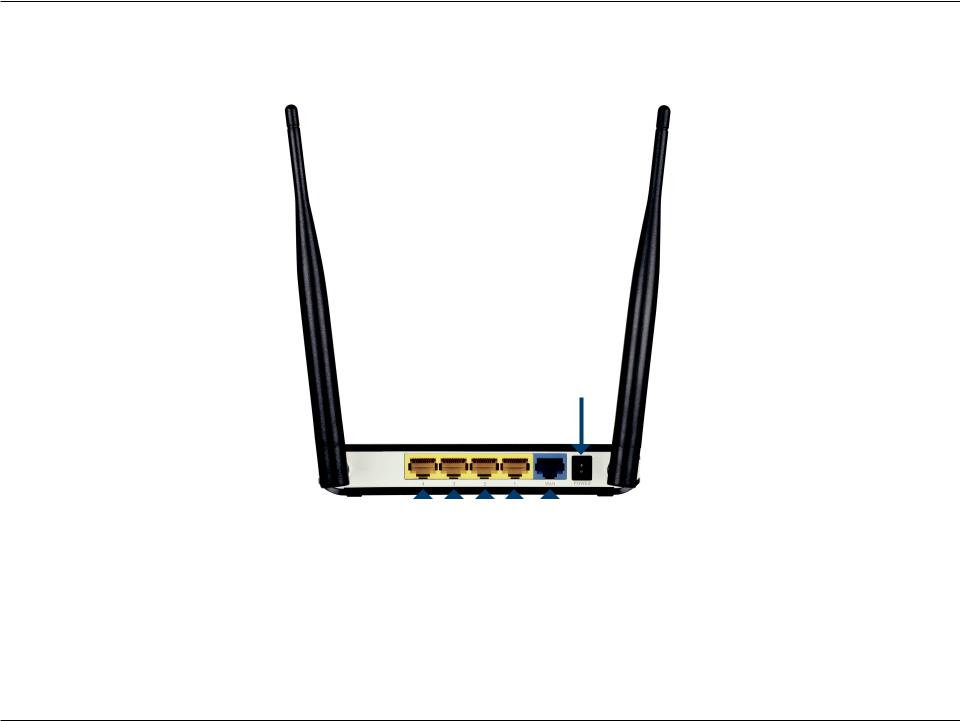
Section 1 - Product Overview
Hardware Overview
Back Panel
POWER
|
|
|
3 |
|
|
|
|
|
LAN |
LAN 1 |
|
||
|
LAN 4 LAN 2 WAN |
|||||
|
|
|
|
|
|
|
Port |
Function |
|||||
LAN Port |
Connects to wired computers or devices. |
|||||
WAN Port |
Connects to the Internet. |
|||||
Power Port |
Connects to the power adapter. |
|||||
D-Link DWR-116 User Manual |
3 |
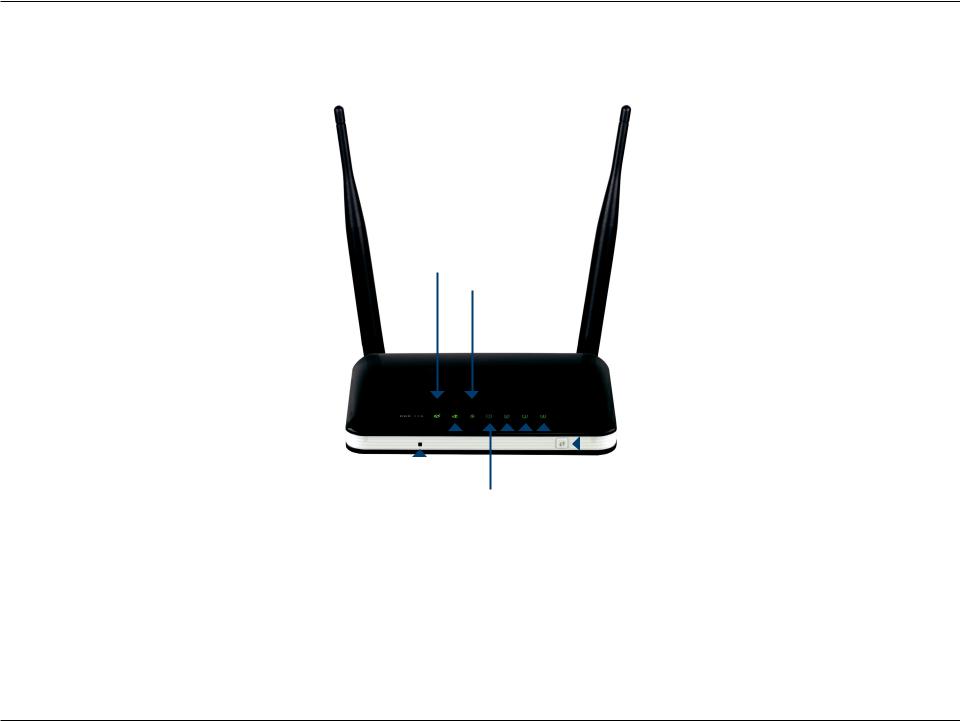
Section 1 - Product Overview
Hardware Overview
Front Panel and LEDs
3G/4G LTE
Wi-Fi
|
|
|
|
|
|
|
|
|
|
WPS BUTTON |
|
|
|
|
|
|
|
|
|
|
|
||
|
|
|
|
|
|
|
|
|
|
|
|
|
|
|
WAN |
|
|
|
|
|
|
|
|
|
|
RESET BUTTON LAN |
|
|
|
|
|
|
|
||
|
|
Ports 1 to 4 |
|
||||||||
LED |
Description |
|
|
|
|
|
|||||
|
Color |
Solid |
|
Blinking |
Blinking (Fast) |
||||||
3G/4G LTE |
Green |
3G/4G LTE connection established |
|
Data transmitting |
- |
||||||
WAN |
Green |
WAN connection established |
|
Data transmitting |
- |
||||||
Wi-Fi |
Green |
Wi-Fi active and available |
|
Data transmitting |
Device in WPS mode |
||||||
LAN 1 - LAN 4 |
Green |
Ethernet connection established |
|
Data transmitting |
- |
||||||
Note: WPS mode can be activated by pressing, and holding the WPS button until the Wi-Fi LED begins to flash rapidly. You can find more details about activating WPS mode in the section titled “Wi-Fi Protected Setup” on page 32
D-Link DWR-116 User Manual |
4 |
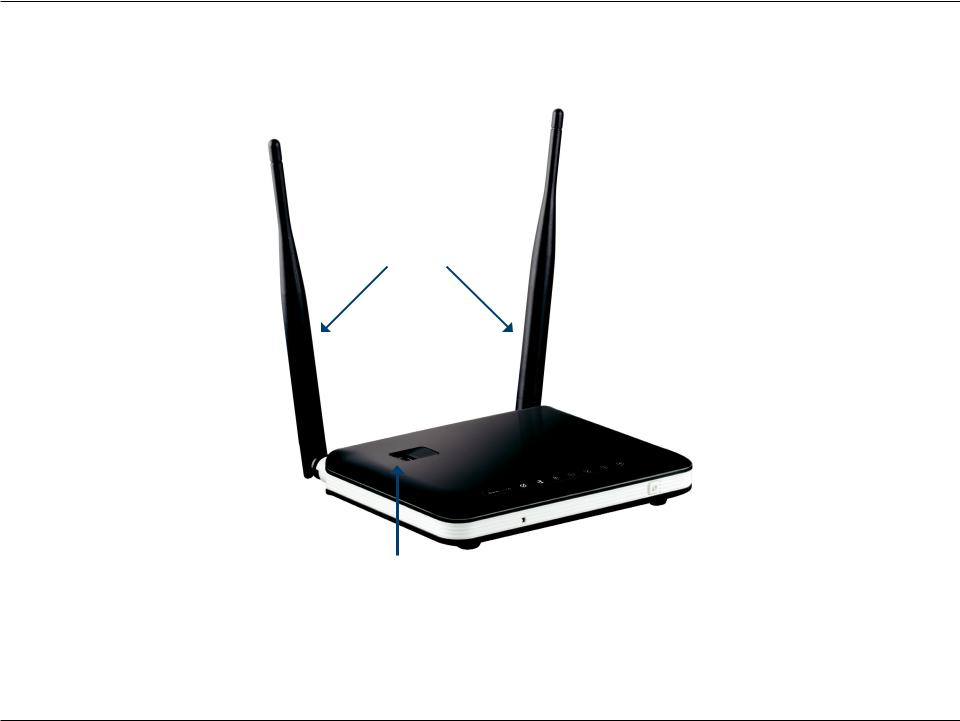
Section 1 - Product Overview
Hardware Overview
Top
External Antennas
|
USB 2.0 Port |
|
|
Port |
Function |
USB Port |
Connects to 3G/4G LTE Modem Dongle |
Antennas |
External WiFi Antennas |
D-Link DWR-116 User Manual |
5 |

Section 2 - Installation
Installation
This section will guide you through the installation process. Placement of the router is very important. Do not place the router in an enclosed area such as a closet or cabinet, or in an attic or garage.
Connect to Your Network
Note: Ensure that your DWR-116 Wireless N300 Multi-WAN Router is disconnected and powered off before performing the installation steps below.
1.Connect a USB modem to the USB port located on the top of the router.
2.Insert an Ethernet network cable into the LAN port on the back of the router. Plug the other end of the Ethernet cable into the LAN port of your computer or laptop. The Ethernet LED will turn green if the Ethernet connection is successfully established.
Note: The DWR-116 Wireless N300 Multi-WAN Router’s LAN ports are“Auto-MDI/MDIX.”Therefore, patch or crossover Ethernet cables can be used.
3. Configure the device using the setup utility.
D-Link DWR-116 User Manual |
6 |

Section 2 - Installation
Wireless Installation Considerations
The DWR-116 can be accessed using a wireless connection from virtually anywhere within the operating range of your wireless network. Keep in mind, however, that the quantity, thickness and location of walls, ceilings, or other objects that the wireless signals must pass through, may limit the range. Ranges vary depending on the types of materials and background RF (radio frequency) noise in your home or office. The key to maximizing the wireless range is to follow these basic guidelines:
1.Minimize the number of walls and ceilings between the router and other network devices. Each wall or ceiling can reduce your adapter’s range from 3 to 90 feet (1 to 30 meters).
2.Be aware of the direct line between network devices. A wall that is 1.5 feet thick (0.5 meters), at a 45-degree angle appears to be almost 3 feet (1 meter) thick. At a 2-degree angle it looks over 42 feet (14 meters) thick. Position devices so that the signal will travel straight through a wall or ceiling (instead of at an angle) for better reception.
3.Try to position access points, wireless routers, and computers so that the signal passes through open doorways or drywall. Materials such as glass, metal, brick, insulation, concrete and water can affect wireless performance. Large objects such as fish tanks, mirrors, file cabinets, metal doors and aluminum studs may also have a negative effect on range.
4.If you are using 2.4 GHz cordless phones, make sure that the 2.4 GHz phone base is as far away from your wireless device as possible. The base transmits a signal even if the phone in not in use. In some cases, cordless phones, X-10 wireless devices, and electronic equipment such as ceiling fans, fluorescent lights, and home security systems may dramatically degrade wireless connectivity.
D-Link DWR-116 User Manual |
7 |
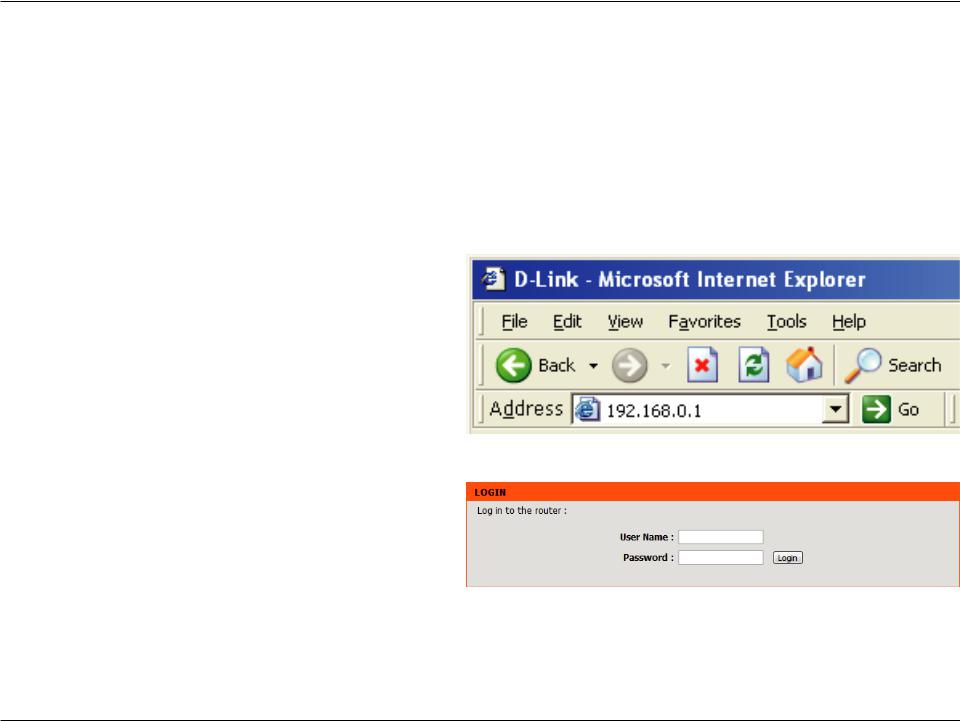
Section 3 - Configuration
Configuration
This section will show you how to configure your new D-Link mobile router using the web-based configuration utility.
Web-based Configuration Utility
To access the configuration utility, open a web-browser such as
Internet Explorer and enter the IP address of the router. The default
IP address of the router is 192.168.0.1.
Type Admin and then enter the password. By default, the password is blank.
If you get a Page Cannot be Displayed error, please refer to the
Troubleshooting section for assistance.
D-Link DWR-116 User Manual |
8 |
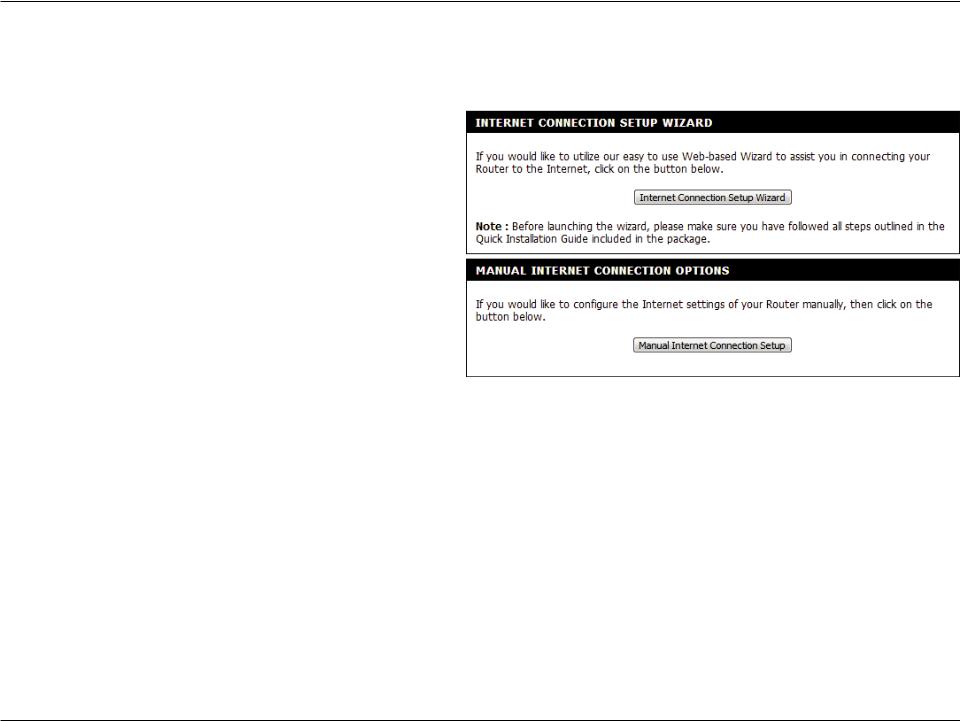
Section 3 - Configuration
Setup
Internet Connection Setup Wizard
The setup wizard guides you through the initial setup of your router. There are two ways to setup your Internet connection.You can use the Web-based Internet Connection SetupWizard or you can manually configure using the Manual Internet Connection Setup wizard.
This wizard will guide you through a step-by-step process to configure your D-Link router to connect to the Internet.
Click Internet Connection Setup Wizard to begin.
If you want to enter your settings without running the wizard, click
Manual Internet Connection Setup and skip to page “Manual
Internet Connection Setup” on page 16.
D-Link DWR-116 User Manual |
9 |
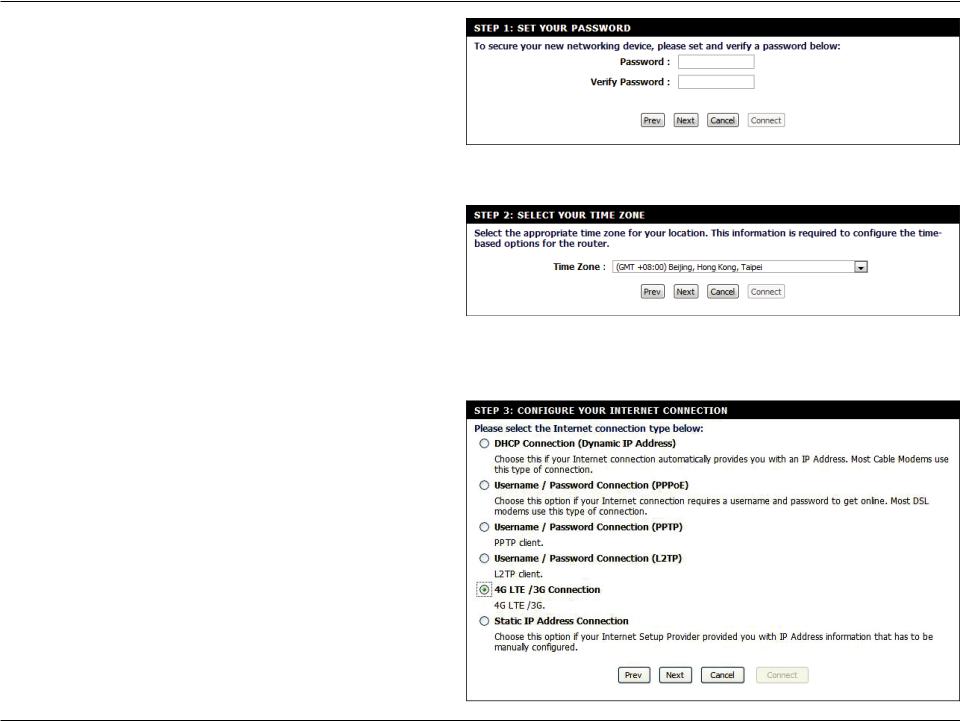
Section 3 - Configuration
Create a new password that will be used to access the router and then click Next to continue.
Click Prev to go back to the previous page or click Cancel to close the wizard.
Select your time zone from the drop-down box and then click Next to continue.
Click Prev to go back to the previous page or click Cancel to close the wizard.
Select the Internet connection type. The connection types are explained on the following page. If you are unsure of the correct connection type, you may have to contact your Internet Service Provider (ISP).
Click Prev to go back to the previous page or click Cancel to close the wizard.
Note:The DWR-116 supports several kinds ofWAN interfaces, allowing you to assign either a WAN or a WWAN(3G/4G LTE) connection as the backup WAN. If the Primary WAN is down or unavailable, configure the backup WAN to Enable, and all the traffic will be routed through backup WAN. This feature is called WAN Failover. You can use WAN Failover if you need redundancy to your Internet connection or any other network.
D-Link DWR-116 User Manual |
10 |

Section 3 - Configuration
The subsequent configuration pages will differ depending on the selection you make during step 3 of the wizard.
DHCP Connection Choose this if your Internet connection automatically provides you with an IP Address. Most cable modems use this type of (Dynamic IP connection. See page 12 for information about how to configure this type of connection.
Address):
Username Choose this option if your Internet connection requires a username and password to connect. Most DSL modems use this style / Password of connection. See page 12 for information about how to configure this type of connection.
Connection (PPPoE):
Username Choose this option if your Internet connection requires Point-to-Point Tunneling Protocol (PPTP). See page 13 for information / Password about how to configure this type of connection.
Connection (PPTP):
Username Choose this option if your Internet connection requires Layer 2 Tunneling Protocol (L2TP). See page 13 for information about how / Password to configure this type of connection.
Connection (L2TP):
3G/4G LTE Choose this option if your Internet Setup Provider provided you with a user name and password to use with your 3G / 4G LTE Connection: enabled USB Dongle. See page 14 for information about how to configure this type of connection.
Static IP Address Choose this option if your Internet Setup Provider provided you with IP Address information that has to be manually configured. Connection: See page 14 for information about how to configure this type of connection.
D-Link DWR-116 User Manual |
11 |
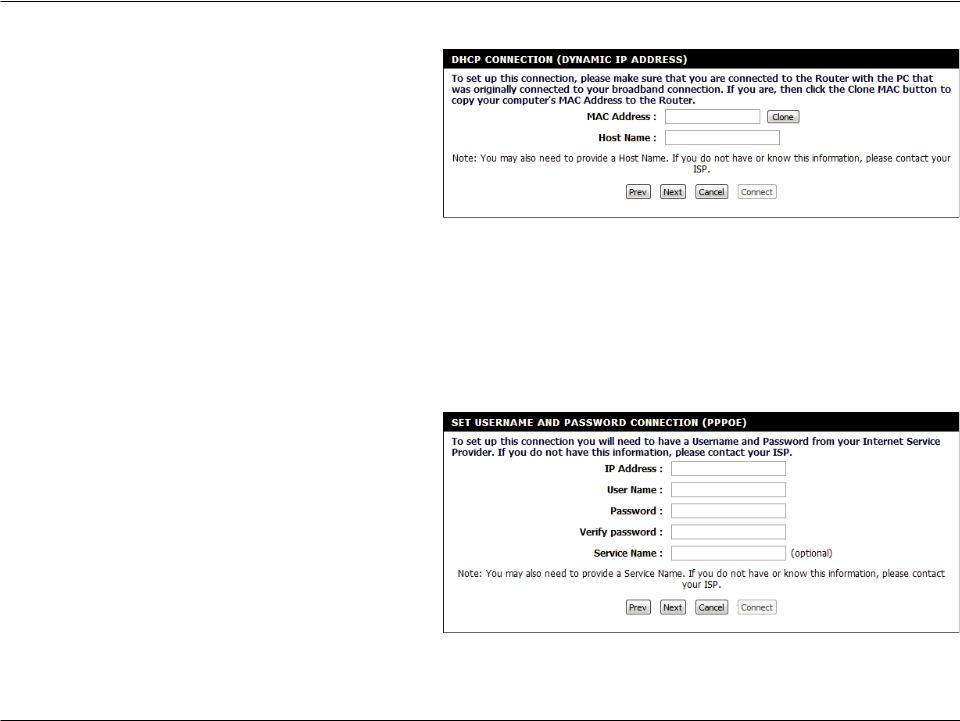
Section 3 - Configuration
DHCP Connection (Dynamic IP Address):
Mac Address: The default MAC Address is set to the Internet port’s physical interface MAC address on the broadband router. It is not recommended that you change the default MAC address unless required by your ISP. You can use the Clone button to replace the Internet port’s MAC address with the MAC address of your PC.
Host Name: Enter the host name for your router or computer.
Click Next to continue, Prev to go back to the previous page or click Cancel to close the wizard.
Username / Password Connection (PPPoE):
IP Address: Fill in if provided by your ISP. If not, keep the default value.
Username: The username/account name that your ISP provides to you for PPPoE dial-up.
Password: Password that your ISP provides to you for PPPoE dial-up.
Service Name: (Optional) Fill in if provided by your ISP.
Click Next to continue, Prev to go back to the previous page or click Cancel to close the wizard.
D-Link DWR-116 User Manual |
12 |
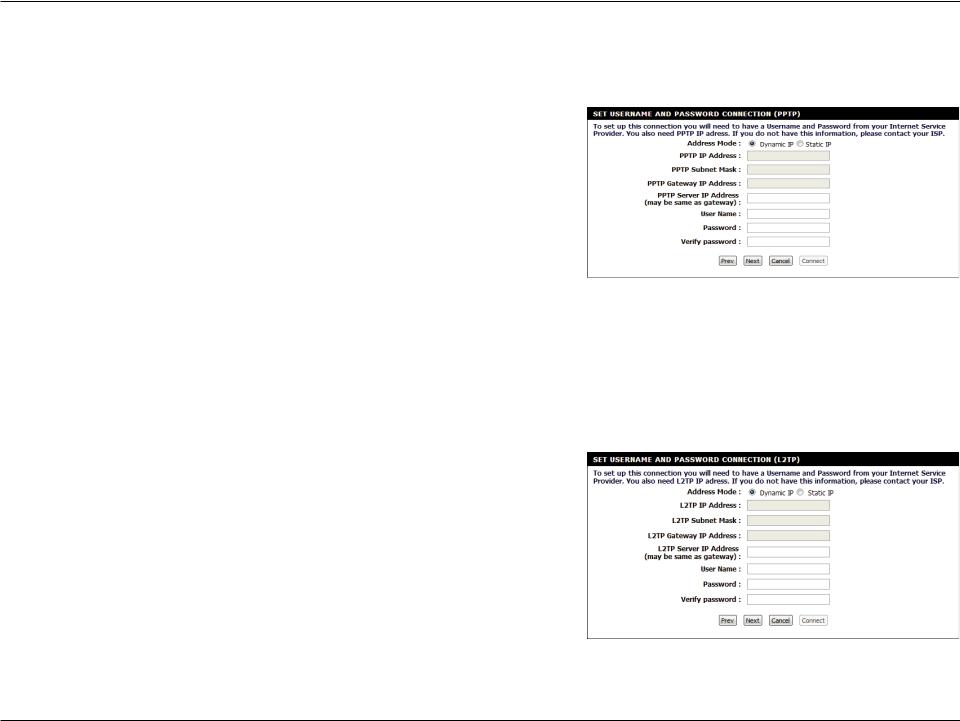
Section 3 - Configuration
Username / Password Connection (PPTP):
Address Mode: Choose Static IP only if your ISP assigns you an IP address.
Otherwise, please choose Dynamic IP.
PPTP IP Address: Enter the information provided by your ISP.
PPTP Subnet Mask: Enter the information provided by your ISP.
PPTP Gateway IP Enter the information provided by your ISP.
Address:
PPTP Server IP IP address of PPTP server.
Address:
User Name: User/account name that your ISP provides to you for PPTP dialup.
Password: Password that your ISP provides to you for PPTP dial-up.
Username / Password Connection (L2TP):
Address Mode: Choose Static IP only if your ISP assigns you an IP address.
Otherwise, please choose Dynamic IP.
L2TP IP Address: Enter the information provided by your ISP.
L2TP Subnet Mask: Enter the information provided by your ISP.
L2TP Gateway IP Enter the information provided by your ISP.
Address:
L2TP Server IP IP address of PPTP server.
Address:
User Name: User/account name that your ISP provides to you for PPTP dialup.
Password: Password that your ISP provides to you for PPTP dial-up.
D-Link DWR-116 User Manual |
13 |
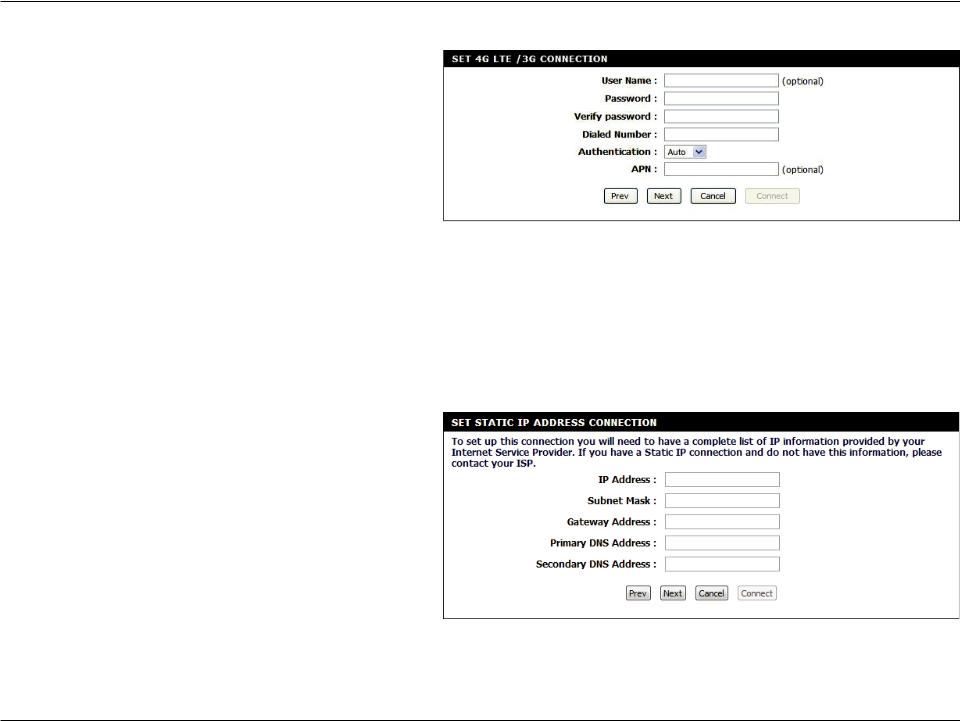
Section 3 - Configuration
3G/4G LTE Connection
User Name: (Optional) Fill in only if requested by ISP.
Password: (Optional) Fill in only if requested by ISP.
Dialed Number: Enter the number to be dialed.
Authentication: Select PAP, CHAP, or Auto detection. The default authentication method is Auto.
APN: (Optional) Enter the APN information.
Static IP Address Connection
IP Address: Enter the IP address assigned to your network connection.
Subnet Mask: Enter the subnet mask.
Gateway Address: Enter the default gateway.
Primary DNS Enter the primary DNS server.
Address:
Secondary DNS Enter the secondary DNS server.
Address
D-Link DWR-116 User Manual |
14 |
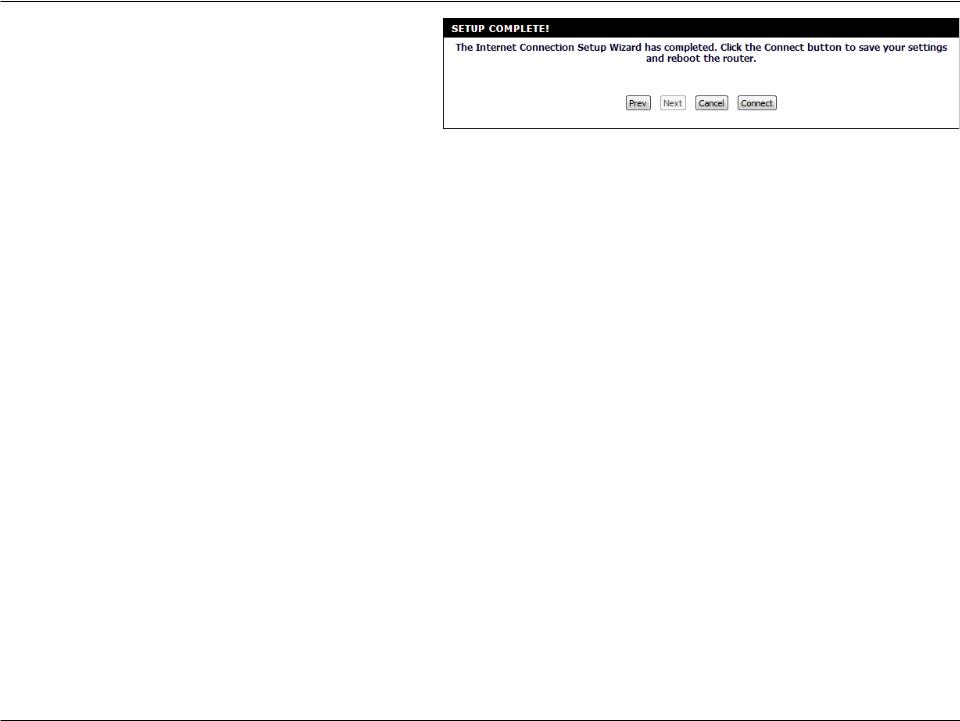
Section 3 - Configuration
You have completed the Setup Wizard.
Click Connect to save your settings.
A popup will appear, to confirm your settings. Click OK to save your settings.
D-Link DWR-116 User Manual |
15 |
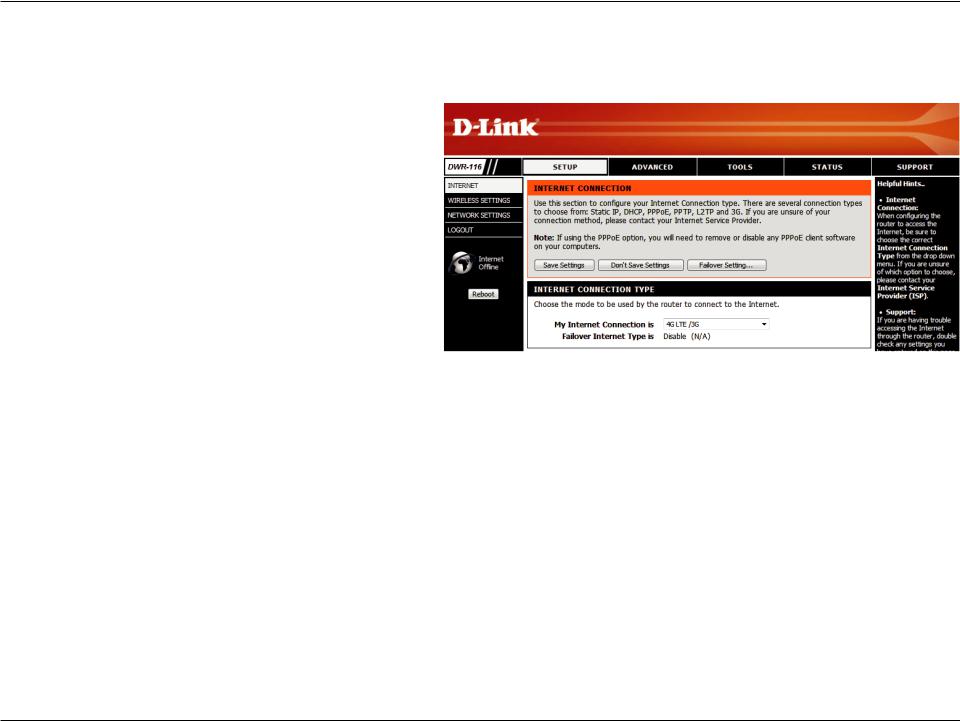
Section 3 - Configuration
Manual Internet Connection Setup
Internet Connection Type
Several different Internet connection types can be selected depending upon the specifications of your Internet Service Provider (ISP).
My Internet Select the Internet connection type specified Connection is: by your Internet Service Provider (ISP). The corresponding settings will be displayed below. Please see the following pages for details on how to configure these different
connection types.
Failover Internet This connection can serve as a backup for Connection is: your default connection. Click on the Failover Setting dropdown box in order to configure this setting. Please refer to page “Failover Setting”on page 23 for more details on how to
configure settings.
D-Link DWR-116 User Manual |
16 |
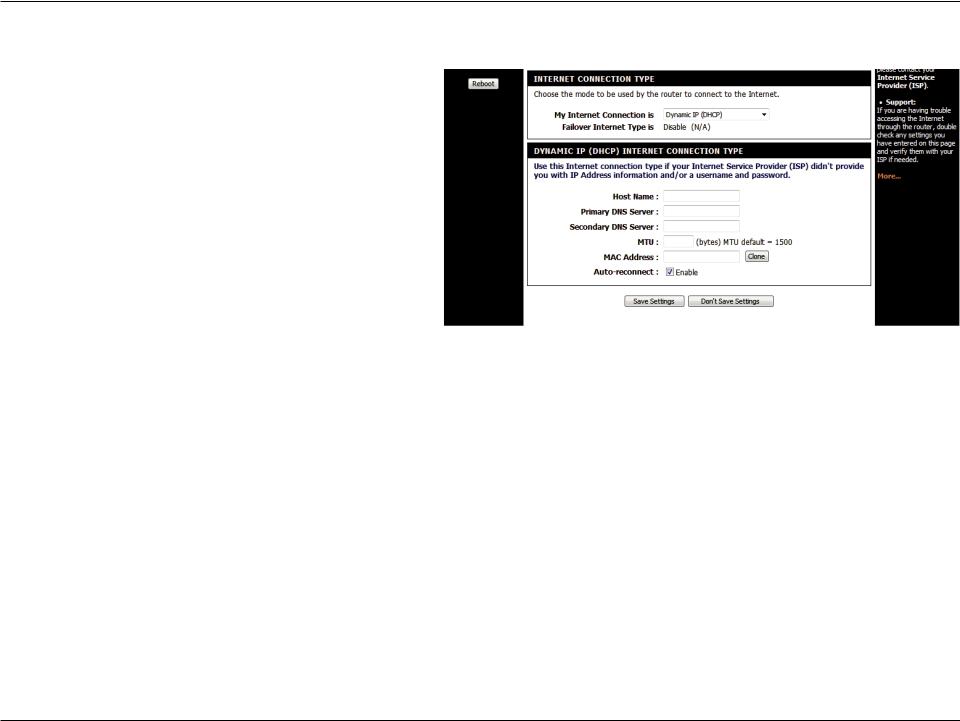
Section 3 - Configuration
Dynamic IP (DHCP)
This section will help you to obtain IP address information automatically from your ISP. Use this option if your ISP didn’t provide you with IP address information and/or a username and password.
Host Name: (Optional) Required by some ISPs.
Primary DNS (Optional) Fill in with IP address of primary
Server: DNS server.
Secondary DNS (Optional) Fill in with IP address of secondary
Server: DNS server.
MTU (Maximum You may need to change the Maximum
Transmission Transmission Unit (MTU) for optimal
Unit): performance. The default value is 1500.
MAC Address: The default MAC address is set to the Internet port’s physical interface MAC address on the broadband router. It is not recommended that you change the default MAC address unless required by your ISP. You can use the Clone button to replace the Internet port’s MAC address with the MAC address of your PC.
Auto-reconnect: This feature enables this product to renew WAN IP address automatically when the lease time is expiring.
Click Save Settings to save your changes, or click Don’t Save Settings to discard your changes.
D-Link DWR-116 User Manual |
17 |

Section 3 - Configuration
PPPoE
Choose this Internet connection if your ISP provides you with a
PPPoE account.
Username: The username/account name that your ISP provides to you for PPPoE dial-up.
Password: Password that your ISP provides to you for
PPPoE dial-up.
Verify Password: Fill in with the same password in Password field.
Service Name: (Optional) Fill in if provided by your ISP.
IP Address: (Optional) Fill in if provided by your ISP. If not, keep the default value.
Primary DNS Server: (Optional) Fill in if provided by your ISP. If not, keep the default value.
Secondary DNS (Optional) Fill in if provided by your ISP. If not, keep the default value.
Server:
MAC Address: MAC address of WAN interface. You can also copy MAC address of your PC to its WAN interface by pressing the Clone button. The Restore MAC button will reset the router to its default MAC address.
Maximum Idle Time: The amount of time of inactivity before disconnecting established PPPoE session. Setting it to zero or enabling Reconnect Mode: Always-on setting will disable this feature.
Maximum You may need to change the Maximum Transmission Unit (MTU) for optimal performance. The default setting of PPPoE is 1492.
Transmission Unit (MTU):
Auto-reconnect: The device will dial-up PPPoE connection automatically.
Click Save Settings to save your changes, or click Don’t Save Settings to discard your changes.
D-Link DWR-116 User Manual |
18 |
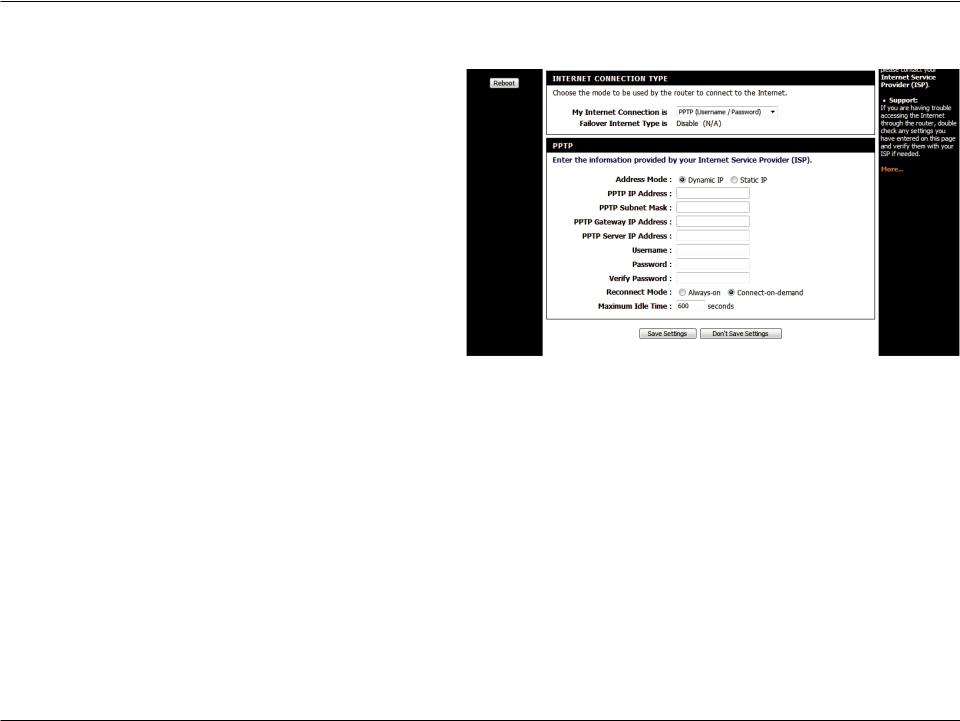
Section 3 - Configuration
PPTP
Choose this Internet connection if your ISP provides you PPTP account.
Address Mode: Choose Static IP only if your ISP assigns you an
IP address. Otherwise, please choose Dynamic IP.
PPTP IP Address: Enter the information provided by your ISP.
|
(Only applicable for Static IP PPTP.) |
PPTP Subnet |
Enter the information provided by your ISP. |
Mask: |
(Only applicable for Static IP PPTP.) |
PPTP Gateway |
Enter the information provided by your ISP. |
IP Address: |
(Only applicable for Static IP PPTP.) |
PPTP Server IP |
IP address of PPTP server. |
Address: |
|
Username: User/account name that your ISP provides to you for PPTP dial-up. |
|
Password: |
Password that your ISP provides to you for PPTP dial-up. |
Verify Password: |
Fill in with the same password in Password field. |
Reconnect |
Choose Always-on when you want to establish PPTP connection all the time. If you choose Connect-on-demand, the device |
Mode: will establish PPTP connection when local users want to surf the Internet, and disconnect if there is no traffic after the time |
|
|
period set under Maximum Idle Time. |
Maximum Idle |
The time of no activity to disconnect your PPTP session. Set it to zero or choose Always-on to disable this feature. |
Time: |
Click Save Settings to save your changes, or click Don’t Save Settings to discard your changes. |
|
|
D-Link DWR-116 User Manual |
19 |
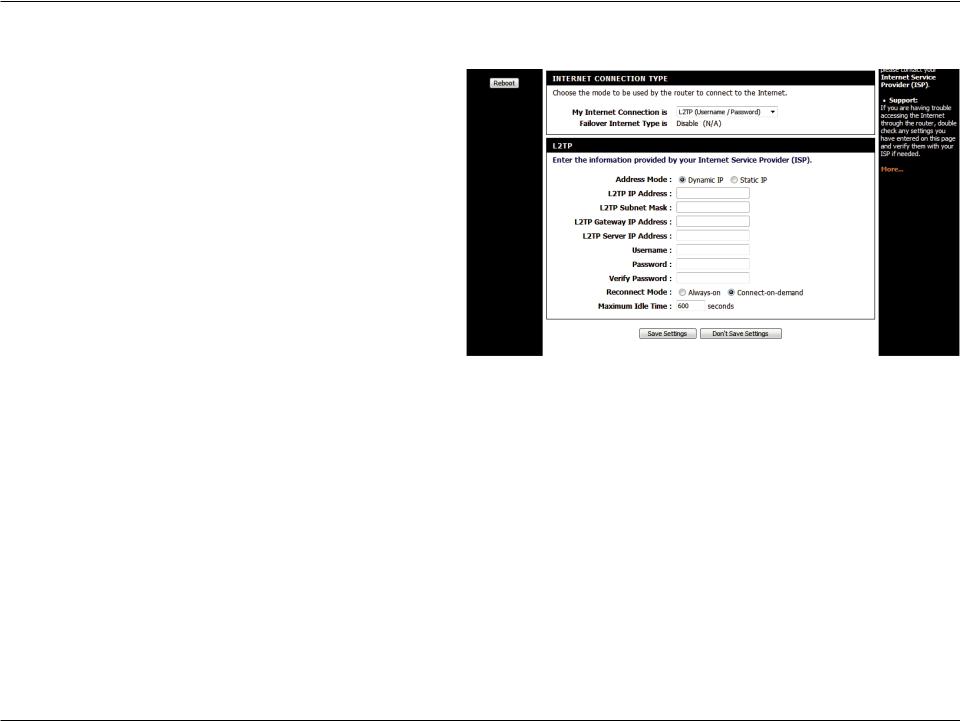
Section 3 - Configuration
L2TP
Choose this Internet connection if your ISP provides you L2TP account.
Address Mode: Choose Static IP only if your ISP assigns you an
IP address. Otherwise, please choose Dynamic IP.
L2TP IP Address: Enter the information provided by your ISP. (Only applicable for Static IP L2TP.)
L2TP Subnet Enter the information provided by your ISP.
Mask: (Only applicable for Static IP L2TP.)
L2TP Gateway IP Enter the information provided by your ISP.
Address: (Only applicable for Static IP L2TP.)
L2TP Server IP IP address of L2TP server.
Address:
Username: User/account name that your ISP provides to you for L2TP dial-up.
Password: Password that your ISP provides to you for L2TP dial-up.
Verify Password: Fill in with the same password in Password field.
Reconnect Choose Always-on when you want to establish L2TP connection all the time. Choose Connect-on-demand and the device will Mode: establish L2TP connection when local users want to surf Internet, and disconnect if no traffic after time period of Maximum Idle
Time.
Maximum Idle The time of no activity to disconnect your L2TP session. Set it to zero or choose Always-on to disable this feature.
Time:
Click Save Settings to save your changes, or click Don’t Save Settings to discard your changes.
D-Link DWR-116 User Manual |
20 |
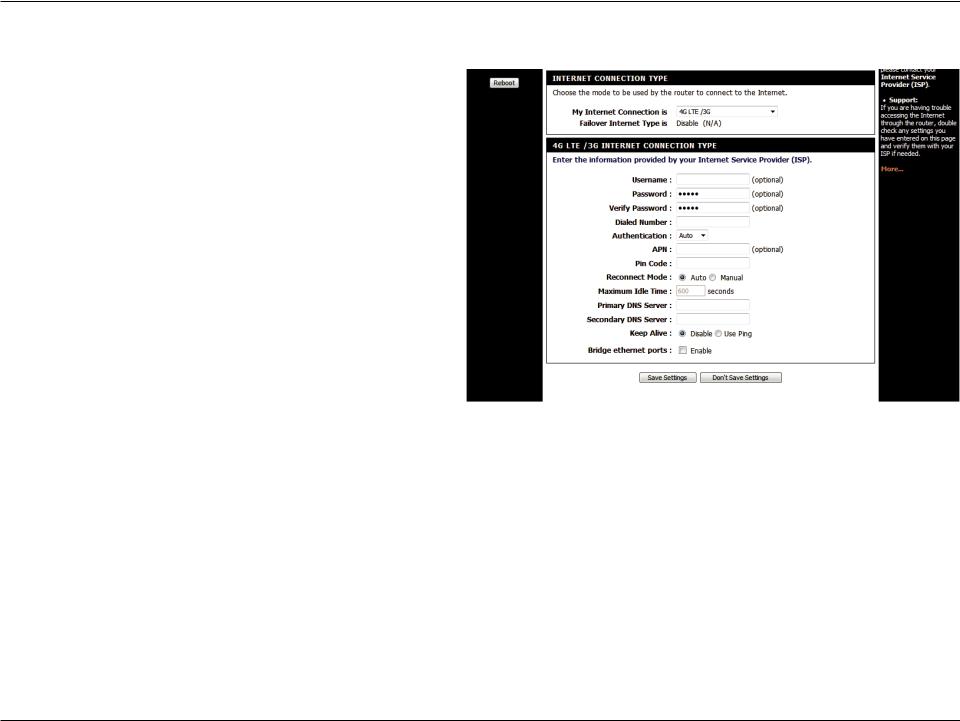
Section 3 - Configuration
3G / 4G LTE
Choose this Internet connection if you already use a SIM card for 3G/4G LTE Internet service from your mobile service provider company. The fields here may not be necessary for your connection. The information on this page should only be used if required by your service provider.
Username: (Optional) Fill in only if requested by ISP.
Password: (Optional) Fill in only if requested by ISP.
Dialed Number: Enter the number to be dialed.
Authentication: PAP, CHAP, or Auto detection. The default authentication method is Auto.
APN: (Optional) Enter the APN information.
PIN: Enter the PIN associated with your SIM card.
Reconnect Mode: Choose whether the device will reconnect to the 3G/4G network automatically or manually
Maximum Idle The time of no activity required to disconnect the established 3G/4G LTE session. Set it to zero or choose Auto in Reconnect Time: Mode to disable.
Primary DNS (Optional) Fill in if provided by your ISP. If not, keep the default value.
Server:
Secondary DNS (Optional) Fill in if provided by your ISP. If not, keep the default value.
Server:
Keep Alive: Disable or Use LCP Echo Request. This depends on ISP requirement.
Bridge Ethernet Activate this feature to change Ethernet WAN port to LAN port.
Ports:
D-Link DWR-116 User Manual |
21 |
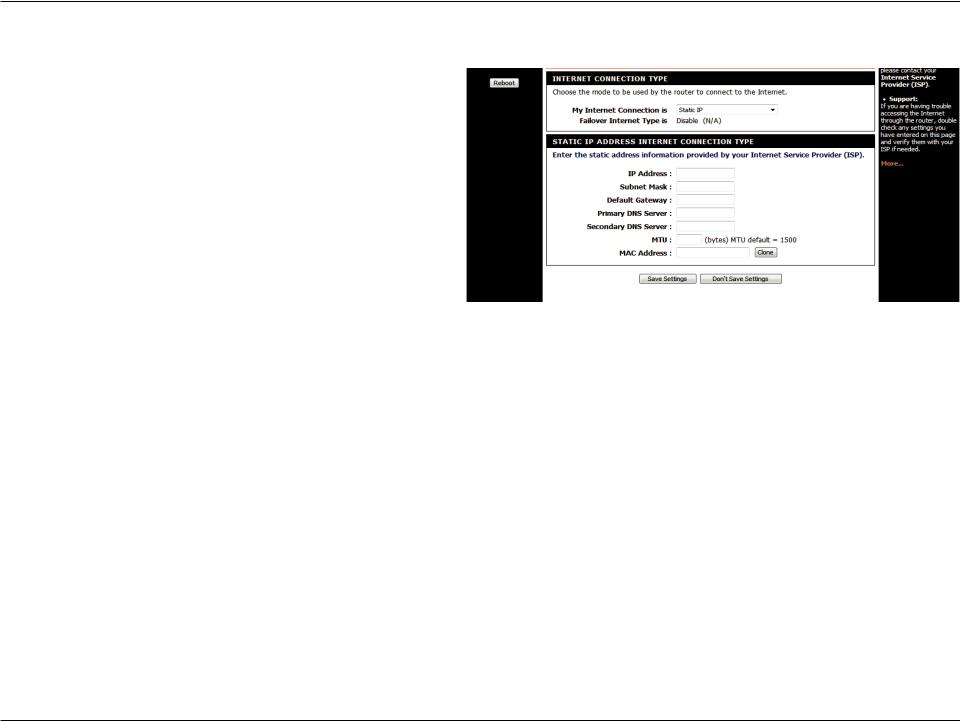
Section 3 - Configuration
Static IP
Choose this Internet connection if your ISP assigns you a static IP address.
IP Address: Enter the IP address assigned to your network connection.
Subnet Mask: Enter the subnet mask.
Default Gateway: Enter the default gateway.
Primary DNS Enter the primary DNS server.
Server:
Secondary DNS Enter the secondary DNS server.
Server:
MTU: You may need to change the Maximum
Transmission Unit (MTU) for optimal performance.
The default value is 1500.
MAC Address: The default MAC Address is set to the Internet port’s physical interface MAC address on the broadband router. It is not recommended that you change the default MAC address unless required by your ISP. You can use the Clone button to replace the Internet port’s MAC address with the MAC address of your Ethernet card.
Click Save Settings to save your changes, or click
Don’t Save Settings to discard your changes.
D-Link DWR-116 User Manual |
22 |
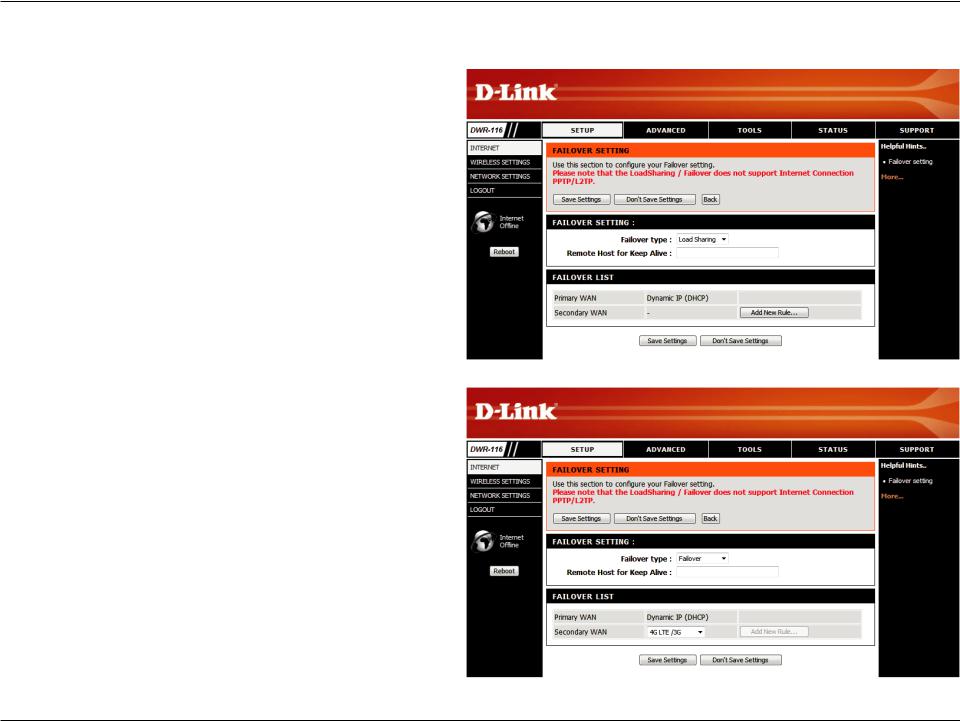
Section 3 - Configuration
Failover Setting
This connection can serve as a backup for your default connection.
Failover Type: This option can be set to either Load Sharing or to Failover. With Load Sharing, the data usage is distributed evenly over the two different internet connections. With Failover, the secondary Internet connection will be in standby mode, until the primary Internet connection fails.
Remote Host for This option should be set to an external IP Keep Alive: address that can be used to ensure that the 3G/4G LTE connection will be kept from going offline due to inactivity. An example would be Google’s public DNS servers (8.8.8.8 or 8.8.4.4) or your Internet service providers DNS servers.
Primary WAN: This will automatically be set to the connection type selected during the Internet connection Setup Wizard, or set to the My Internet Connection is option which is found on the Manual Internet Connections settings page.
Secondary WAN: This can be set by clicking on Add New Rule, the available options will be shown in the drop down box that appears.
Click Save Settings to save your changes, or click Don’t Save Settings to discard your changes.
D-Link DWR-116 User Manual |
23 |
